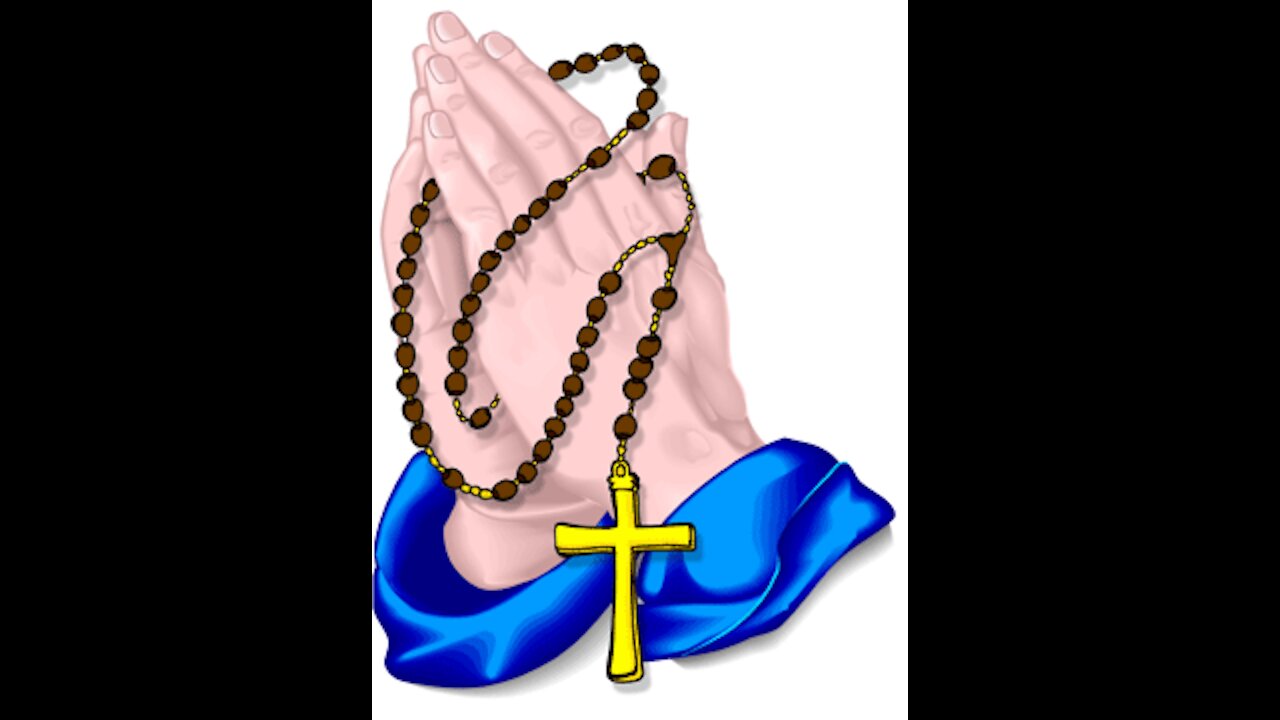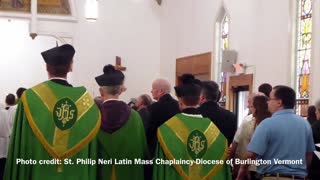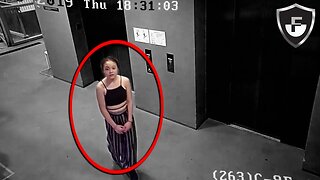Premium Only Content

All About the Rosary for Kids - Why pray it? Where did it originate from? How do you pray it?
In this video you'll learn all about the Rosary.
What is it? Where did it come from? Why Should we Pray it? And HOW do we pray it?
Let’s start with Why pray it? Because our mom said so! The Mother of God, Our Lady, the Blessed Virgin, Queen Of Heaven and Earth...Mama Mary goes by many names and has appeared numerous times throughout history with the Rosary and has encouraged us to pray it daily.
The first notable appearance (also known as an apparition) was in the early 13th century, when Our Lady appeared to St Dominic and presented him with a Rosary, both the beads and the prayers to go with it.
And the more recent notable apparition was when our Blessed Mother appeared to 3 children in Fatima, Portugal in 1916.
Our lady encouraged the children to pray the rosary daily in order to bring peace to the world and end the war.
One of the 10 commandments is to honor thy father and mother, so you better listen, especially when it’s the Mother of God!
Jesus set the example for us when he obeyed his Mother and performed his first public miracle at her request turning water into wine at the wedding of Cana. Even though he said “my time has not yet come,” he listened and obeyed his mother and did as she asked.
That is what makes Mary such a powerful prayer partner, she will work on our behalf to bring our requests to her Son. We called this intercession - - and it’s what we do every time we pray the Rosary!
Now that we know a little more about WHY we pray the Rosary lets talk about what it is exactly and how we pray it.
The word Rosary comes from the Latin word Rosarium which means “Garland of Roses” A priest from our Pariah once said that when you pray the Rosary it’s like dropping roses at the foot of Mary. And the Rosary is a beautiful way to not only honor our Mother in Heaven but it’s a powerful prayer that draws us closer to her Son.
The prayers that comprise the Rosary are arranged in sets of ten Hail Marys, called decades. Each decade starts with one "Our Father" and finishes with one Glory Be, and per Our Lady’s request at Fatima, we add in what’s called the Fatima Prayer which starts "Oh my Jesus".
A typical Rosary contains 5 decades and as we pray each decade we think about the different important events in the lives of Jesus and Mary. These events are called Mysteries or Meditations since we are trying to focus our mind on a particular thought.
There are 3 traditional sets of 5 Mysteries -- the Joyful, Sorrowful, and Glorious Mysteries.
Traditionally we pray a certain set of Mysteries on certain days of the week or during certain liturgical seasons. The Joyful Mysteries are typically prayed on Mondays and Thursdays. During the liturgical seasons of Advent, Christmastide and the time after the Epiphany the Joyful Mysteries may also be prayed on Sundays. The Sorrowful Mysteries are typically prayed on Tuesdays and Fridays, and during the liturgical season of Septuagesima and Lent may be prayed every day. The Glorious Mysteries are typically prayed on Wednesdays and Saturdays, and during the liturgical seasons of Eastertide and the time after Pentecost the Glorious Mysteries are prayed on Sundays.
If you add up all 3 sets, you get a total of 15 decades which equals 150 Hail Marys, and is symbolic as it ties back to the ancient practice of praying the Psalter of David.
The Psalter of David relates to the 150 Psalms and have always been prayed by Old Testament Israel, post-Temple Jews, and Christians. However in the early days many people could not read and copies of the Bible weren’t exactly easy to come by - the Bible wasn’t mass produced until the invention of the printing press in the 15th century - so people who didn't have copies of Scripture would substitute 150 Our Fathers or Hail Marys in place of the 150 Psalms they could not read.
And if you add the 150 Hail Marys with the 3 Hail Marys prayed at the beginning you get 153 which happens to be the number of days covered by Mary’s appearances at Fatima, neat, huh? Another cool thing about the number 153 is that it can be found in scripture in John chapter 21, versus 4 to 13 - it’s the number of fish caught! It’s also been said at the time of the miracle of the fish there were 153 known nations in the world...pretty cool, huh?
The prayers of the Psalter or Rosary were originally counted by transferring pebbles from one bag to another, but soon enough Christians began to tie a rope with knots on which to count. This evolved further into using beads or pieces of wood in place of the knots, and this soon came to be called the "Psalter of the Laity."
(Laity meaning common people within the Church community)
Around the end of the first millennium, Rosaries contained the present five decades (sets of ten beads), with the Hail Mary beads shaped like white lilies for the purity of the Virgin, and the Our Father beads shaped like red roses for the wounds and Passion of Christ.
-
 14:50
14:50
Traditional Catholic Faith for Kids
4 years ago $0.14 earnedIntro to the Latin Mass for Kids - Helping Children Learn the Traditional Catholic Faith TradKidsTV
7371 -
 12:25
12:25
Lynda Cromar Online Training
4 years agoFeel Good About Where You Are Now!
31 -
 55:24
55:24
Church of Pentecost Sermons
4 years agoThink About This, Where Is Your Real Treasure?
131 -
 2:49
2:49
HowStuffWorks_Science
4 years agoBrainStuff: Where Did Neckties Come From?
66 -
 3:12
3:12
HotZone
4 years ago $0.11 earnedLet's Talk about the Kids "Separated" from their Parents
536 -
 12:23
12:23
sumnameforus
4 years ago $0.02 earnedWhere did plastic come from?
80 -
 0:45
0:45
STLNutritionDoc
4 years agoHow do YOU feel about this?
1.41K -
 4:51
4:51
Transforming Our Understanding
4 years agoWhere Did Our Content Come From?
78 -
 15:24
15:24
Tactical Advisor
22 hours agoBest 2011 of 2025 | Bul Armory Ultralight Pro
37.3K2 -
 27:31
27:31
True Crime | Unsolved Cases | Mysterious Stories
2 days ago $0.22 earnedThe Hong Kong Schoolgirl Mystery – 5 Mysterious Unsolved Cases (Part 8)
26.6K5